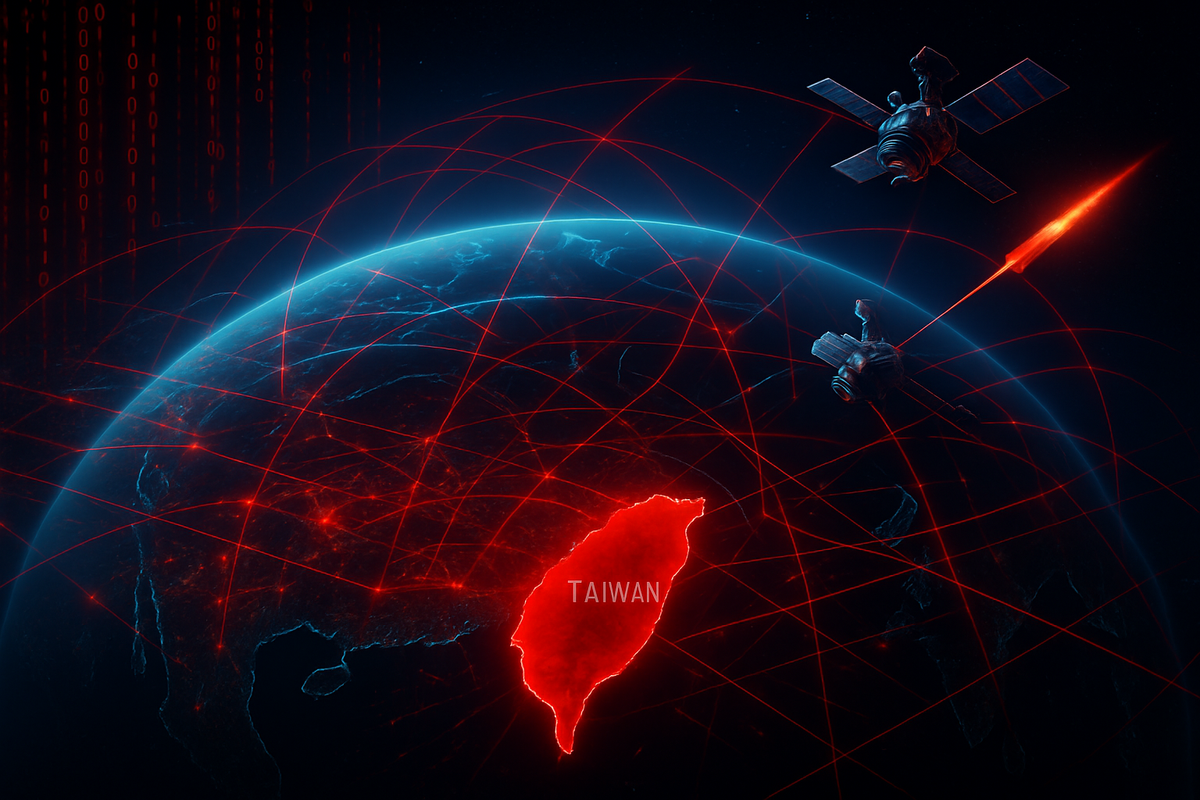World War 3.0? Why Taiwan, Space, and Cyberattacks Are the New Frontlines
Forget boots on the ground World War 3.0 will be fought through code, satellites, and silicon chips.

Introduction: The Battlefield Has Changed
Forget tanks rolling across Europe or battleships at sea. If there ever is a World War 3, it likely won’t look like anything we’ve seen before. We’re already seeing the early tremors of World War 3.0 a conflict defined by invisible lines, digital sabotage, and geopolitical chokeholds. And while no missiles have yet flown in a global war, the frontlines are forming Taiwan, Outer Space, and Cyberspace.
This isn’t just speculation. It’s a multi-dimensional chess game playing out between the world’s superpowers, with stakes higher than oil or land: technology, data, sovereignty, and survival in a digitized era.
Let’s unpack why these new frontlines are emerging, who’s involved, and how this war might be waged without a single shot until it's too late.
I. Taiwan: The Flashpoint of the Pacific
A Tiny Island With Global Consequences
At the heart of the Taiwan Strait lies one of the most dangerous geopolitical powder kegs of the 21st century. Taiwan, an island roughly the size of the Netherlands, sits just 100 miles off the coast of China and Beijing considers it a breakaway province, not a sovereign nation. Meanwhile, Taiwan operates like a fully independent state, with its own government, military, and foreign relations.
Why does this matter to the world?
Because Taiwan is the beating heart of the global tech economy, producing over 60% of the world's semiconductors and more than 90% of the most advanced chips, thanks to companies like TSMC (Taiwan Semiconductor Manufacturing Company). A disruption here wouldn't just affect iPhones and laptops it would freeze economies, cripple military systems, and trigger a full-blown global tech crisis.

China’s Growing Assertiveness
In the past few years, China has stepped up military drills around Taiwan, flying jets into its air defense identification zone and simulating blockade scenarios. The rhetoric from Beijing is sharper than ever, openly suggesting "reunification" by force if necessary.
This isn’t just nationalism it’s strategy. Taiwan’s control of semiconductor technology gives it strategic leverage, and its alignment with the U.S. and allies like Japan makes it a potential launchpad for military resistance to China's regional dominance.
U.S. Military Positioning
The United States has responded by:
- Increasing arms sales to Taiwan
- Conducting freedom of navigation operations in the South China Sea
- Establishing new alliances, like AUKUS (Australia, UK, U.S.)
- Deploying advanced missile systems in Pacific bases
Any direct conflict over Taiwan would draw in China, the U.S., Japan, Australia, and possibly NATO. That’s not just a skirmish that’s World War 3.0 ignition.
II. Space: The New Cold War Above Our Heads
Satellites: The Soft Targets of the Sky
In the 20th century, space was a symbol of innovation. In the 21st century, it’s becoming a battlefield.
There are currently over 8,000 operational satellites orbiting Earth used for everything from GPS and communication to climate monitoring and missile guidance. Knocking out a few of them would be the digital equivalent of blinding your enemy before the fight even starts.
Weaponizing Space
Russia, China, and the U.S. have all tested anti-satellite (ASAT) weapons, capable of destroying orbiting assets. This raises chilling questions:
- What happens when a military satellite goes dark mid-conflict?
- What if GPS signals are spoofed or disabled?
- What if space debris from a targeted satellite causes a cascading collision (Kessler Syndrome), crippling all space-based systems?
There’s also an emerging risk of cyberattacks on satellites, where hostile actors take over satellite controls without launching a missile.
Space Force Isn’t Science Fiction Anymore
The U.S. Space Force, formed in 2019, now operates under a real doctrine: defending U.S. interests in orbit. China has its own military space wing, and Russia has openly admitted to developing space-based weapons.
From hypersonic glide vehicles launched from low orbit to AI-directed swarms of satellites, space is no longer just the high ground it’s the first strike zone of any future global war.
III. Cyberwarfare: Invisible but Devastating
The Quietest War Already Underway
The frontlines of World War 3.0 are already inside your phone, bank, hospital, and power grid. Unlike traditional wars, cyberattacks don’t need a declaration they just need code.
From Russian ransomware groups targeting American hospitals, to Chinese cyber-espionage campaigns stealing defense secrets, to North Korean hackers funding missile programs through crypto theft cyberwar is happening every day, beneath the surface.
Infrastructure Is the Target
Consider what happened in:
- Ukraine (2022–2023): Power grids, railway systems, and government databases were all attacked by Russian cyber units.
- U.S. Colonial Pipeline Hack (2021): A single ransomware attack disrupted fuel supply across the East Coast.
- India (2024): Alleged Chinese-origin malware was found targeting power grids near the Ladakh border.
These aren’t just crimes they’re acts of war without bullets.
The Rise of AI in Cyberattacks
Now throw AI into the mix machine-generated attacks, deepfake disinformation campaigns, and self-mutating malware. We’re entering a world where AI-powered cyberattacks can:
- Impersonate officials in real-time
- Deploy automated financial attacks across global banks
- Infect nuclear command-and-control systems
The nightmare scenario? An AI-initiated conflict through false alerts, spoofed radar data, or hacked defense systems, prompting a real-world military response.

IV. The New Rules of Engagement: Gray Zones & Proxy Players
Who Fires the First Shot in a World War with No Borders?
In this new version of warfare, traditional definitions of war are obsolete. There is no need to “declare” war anymore conflict now operates in the gray zone, where it's unclear who the attacker is, what the rules are, and how nations should respond.
Expect to see more:
- Proxy conflicts (e.g., Iran-backed groups vs Israel, or Chinese militias in disputed waters)
- State-sponsored cyber gangs operating without clear military oversight
- Economic warfare (e.g., freezing national assets, blocking chip exports)
- Legal warfare (weaponizing international law and sanctions)
World War 3.0 might look less like Normandy and more like a thousand tiny cuts across economies, societies, and systems until a tipping point is reached.
V. Who’s on Whose Side? The Global Fault Lines
If this hypothetical war does break out, the world could fracture into technological and ideological blocs rather than old-fashioned alliances:
The Techno-East Bloc
- China
- Russia
- Iran
- North Korea
- Several African and Middle Eastern nations attracted to non-Western digital infrastructure (Huawei, BeiDou, BRICS+)
The Digital Democracies
- U.S.
- NATO
- Japan
- India
- Australia
- South Korea
These alliances may revolve less around territory and more around data flow, chip manufacturing, AI sovereignty, and information dominance.
VI. Could World War 3.0 Be Prevented?
This isn’t just doomsday theorizing—many experts believe the next world war could begin and end in the digital domain, with enough restraint and diplomacy to prevent escalation. But that assumes rational actors, mutual deterrence, and real-time crisis management—all of which are fragile.
Several things must happen to avoid catastrophe:
- International treaties on cyberwarfare and space militarization
- Backup systems for global communications (quantum networks, mesh satellites)
- Transparency between superpowers on red-line protocols
Global AI governance to prevent autonomous systems from acting unpredictably

Conclusion: Welcome to World War 3.0
The scariest thing about World War 3.0? It may have already started.
There are no parades, no declarations, no headlines screaming “WAR.” But behind the scenes, we are already watching a digital Cold War morph into something more volatile. The battle for Taiwan, the race for space supremacy, and the daily skirmishes in cyberspace are all threads in the same unraveling web.
It’s not about who has the most nukes anymore it’s about who controls the chips, the satellites, the algorithms, and the narratives.
And when the first missile does fly, it won’t be the beginning. It’ll be the reveal of a war that was already well underway.
Sources:
- CSIS (Center for Strategic & International Studies)
- Taiwan Strait Conflict Tracker
- https://www.csis.org
- TSMC Official Website & Investor Reports
- BBC News – Taiwan & China Military Tensions
- Bloomberg – The Chip War and Taiwan’s Global Role




